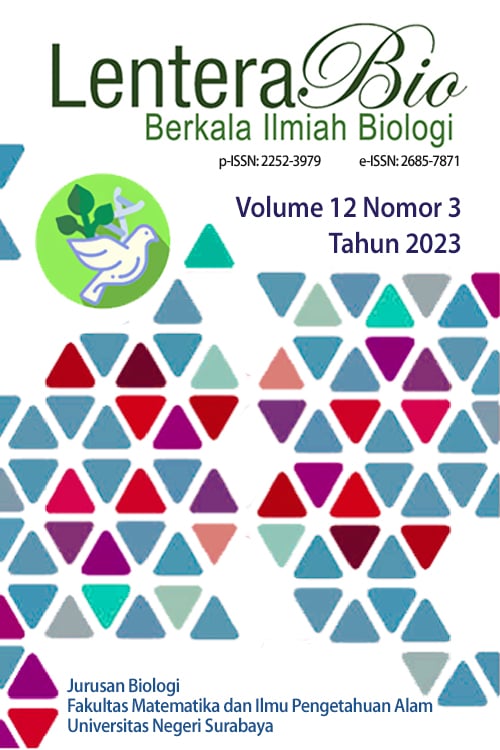Phytoremediation of Phosphate from Synthetic Detergent Using Lemna minor and Azolla microphylla
DOI:
https://doi.org/10.26740/lenterabio.v12n3.p281-189Keywords:
Phytoremediation, Phosphate, Lemna minor, Azolla microphyllaAbstract
Detergent waste is one of the causes of water pollution. One of the detergent ingredients is Phosphate. Phosphate in the waters will cause eutrophication and endanger aquatic biota. One of solution to reduce phosphate levels in waters is use Lemna minor and Azolla microphylla as phytoremediators. This study aims to determine the effect of plant species and detergent concentration on phosphate levels. This was an experimental study using Randomized Block Design (RBD) with two treatment factors, it is the species Lemna minor and Azolla microphylla and detergent concentrations of 10 ppm and 20 ppm. Parameters tested included phosphate, temperature, pH, DO, BOD and leaf chlorophyll content. Data analysis was carried out using two-way ANOVA followed by Duncan's test to determine the relationship between plant species and concentration on the decrease in phosphate levels. The results showed that plant species had an effect on decreasing phosphate levels. The highest decrease in phosphate levels occurred in Azolla microphylla at 20 ppm concentration with 79.54% and the lowest is in Lemna minor at 20 ppm concentration with 55% reduction. The lowest chlorophyll content was in Lemna minor at a concentration of 10 ppm which was 5.74 mg/L while the highest chlorophyll content was in Azolla microphylla at a concentration of 20 ppm which was 11.77 mg/L.
Downloads
Published
How to Cite
Issue
Section
License
Copyright (c) 2023 LenteraBio : Berkala Ilmiah Biologi

This work is licensed under a Creative Commons Attribution-NonCommercial 4.0 International License.
Hak Cipta (c) LenteraBio: Berkala Ilmiah Biologi
Karya ini dilisensikan di bawah Lisensi Internasional Creative Commons Attribution-NonCommercial 4.0.
Pemberitahuan Hak Cipta.
Hak cipta dari artikel yang diterima untuk diterbitkan akan diberikan kepada jurnal sebagai penerbit jurnal. Hak cipta yang dimaksud meliputi hak untuk menerbitkan artikel dalam berbagai bentuk (termasuk cetak ulang). Jurnal mempertahankan hak penerbitan atas artikel yang diterbitkan.
 Abstract views: 1403
,
Abstract views: 1403
, PDF Downloads: 2505
PDF Downloads: 2505











